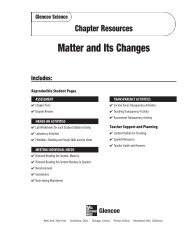Chapter 2 Resource: Measurement - Learning Services Home
Chapter 2 Resource: Measurement - Learning Services Home
Chapter 2 Resource: Measurement - Learning Services Home
- No tags were found...
Create successful ePaper yourself
Turn your PDF publications into a flip-book with our unique Google optimized e-Paper software.
Name Date Class<br />
(continued)<br />
Hands-On Activities<br />
5. Before you begin, create a data table on a separate sheet of paper. Your group must decide on<br />
its design. Be sure to leave enough room to record the results for each person’s time. If more<br />
than one trial is to be run for each measurement, include room for the additional data.<br />
Follow Your Plan<br />
1. Make sure that your teacher approves your plan before you start.<br />
2. Carry out the experiment as planned and approved.<br />
3. Be sure to record your data in the data table as you proceed with the measurements.<br />
Analyze Your Data<br />
1. Graph your data. What type of graph would be best<br />
2. Are your data table and graph easy to understand Explain.<br />
3. How do you know that your measurements are precise<br />
4. Do any of your data appear to be out of line with the rest<br />
Conclude and Apply<br />
1. Explain how it is possible for different members of a group to find different times while measuring<br />
the same event.<br />
2. Infer what tools would help you collect more precise data.<br />
3. What other data displays could you use What are the advantages and disadvantages of each<br />
Communicating Your Data<br />
Make a larger version of your graph to display in your classroom with the graphs of other<br />
groups. For more help, refer to the Science Skill Handbook.<br />
Copyright © Glencoe/McGraw-Hill, a division of the McGraw-Hill Companies, Inc.<br />
8 <strong>Measurement</strong>














